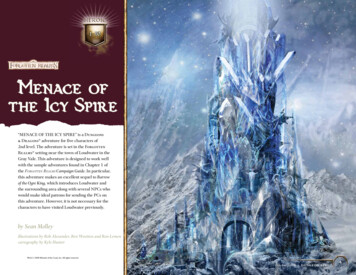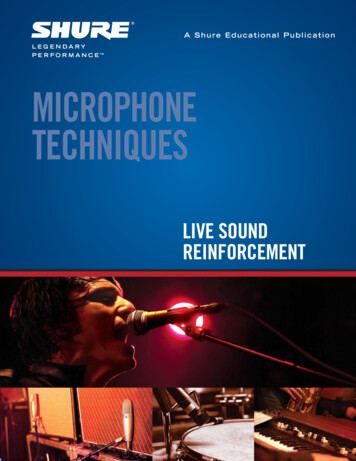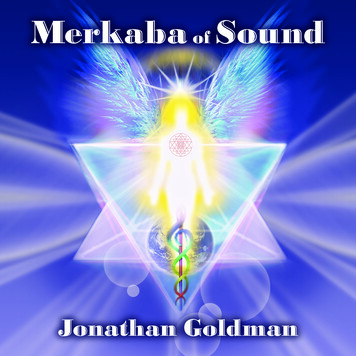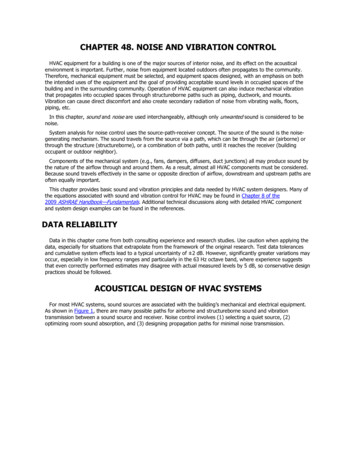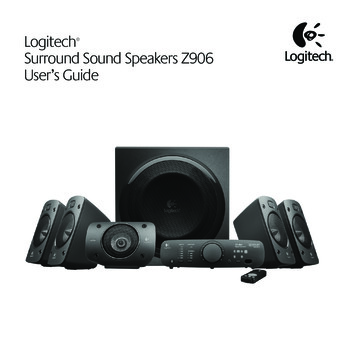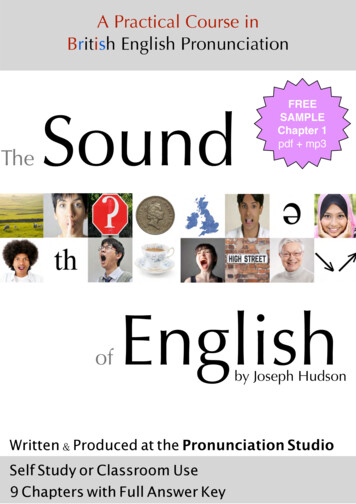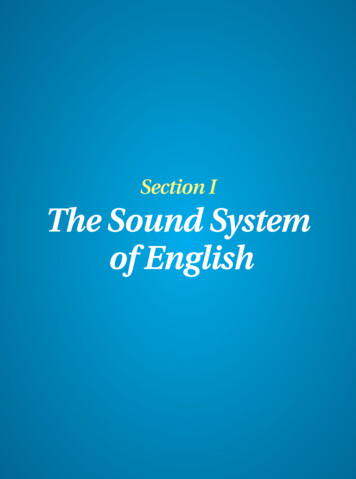
Transcription
Section IThe Sound Systemof English 2013, Dayalbagh Educational InstituteSpoken English - Section 11
IntroductionAll languages have two forms, the oral and the written. Words in any spokenlanguage are primarily a combination of various speech sounds. Hence to speakany language the first essential thing is to produce the sounds of that languagecorrectly.In languages such as Hindi, each sound has one letter to represent this in thewritten form. However, it is not so in the English language. English has 44 soundsbut only 26 letters to represent them. Hence various combinations of letters areused to represent these sounds; sometimes the same letter (or a combination ofletters) may represent different sounds. For example, the letter ‘c’ represents twodifferent sounds as shown below.1) ‘C’ as in care, cake and cat (with/k/sound)2) ‘C’ as in cinema, cell and city (with/s/sound)Therefore, it is not necessary that the written form of the word may match thesound produced by it. This means that the sounds of English language need tobe correctly acquired to bring accuracy in our speech.The use of silent letters sometimes complicates pronunciations in English; thus,“knife” and “calm” which contain the silent letters “k” and “l”, respectively, are notpronounced the way they are spelt.Further, when we put together the sounds of English to produce continuousspeech, we need to pay attention to some other features of English such asstress and intonation patterns, strong and weak forms of words, etc. When wespeak sentences in English all words are not pronounced with the same breathforce. Some words are spoken strongly with greater breath force while others arespoken relatively weakly. For example:Send him away.Put it in on the table.In the above sentences the highlighted parts of the words are spoken with greaterforce, while the others are gone through rapidly with less force.Within the same word too, some parts are spoken with more force than others.For example:International, application, teacher, because.In English the varying breath force is called stress while change in the pitch of thevoice is called intonation. To be able to communicate accurately and fluently inEnglish the speaker must understand and use these features appropriately.Lessons 1, 2 and 3 deal with the production of the individual sounds of Englishlanguage. Stress, intonation and other features of connected speech are discussedin lesson 4 of this section.2Spoken English - Section I 2013, Dayalbagh Educational Institute
LESSON IThe Sounds of EnglishIn the English alphabet there are 26 letters, but these letters produce 44 sounds. For this reason,one letter is used to produce more than one sound. In order to know the correct pronunciationcertain symbols denoting these sounds have been devised and standardized. By learning thesesymbols you will be able to find the correct pronunciation of any word in a standard dictionary.These symbols will also help you to go through the book with guidance for correct pronunciationof words and conversations. These sounds are classified into two types:Figure 1.1: Sounds of English(i) What is a vowel sound?There are only 5 vowel letters in English (a,e,i,o,u), but the sounds indicated by these 5 letters are20. A vowel sound is produced when the air comes out of the mouth freely without any blockageor closure in the mouth cavity by the tongue, teeth, lips, etc. The vowel sounds are of two types:Single vowel sounds: When these sounds are produced, the tongue remains in the same positioneven when the sound is prolonged. They consist of one sound only and are called pure vowels asin ‘sit’, ‘pot’, ‘heat’, etc. (the underlined letters indicate the single vowel sounds)Double vowel sounds: These vowel sounds are a combination of two single vowel sounds and inpronouncing them the tongue moves from one position to another. For instance, in the word ‘light’the sound of ‘i’ is a combination of the vowel sounds /a:/ as in ‘art’ and /i/ as in ‘it’. Thewords ‘hair’, ‘toy’ and ‘poor’ also contain double vowel sounds.You will find that sometimes two vowel letters may produce a single vowel sound as in ‘heat’,whreas, a single vowel letter may produce a double vowel sound as in ‘light’ explained above. 2013, Dayalbagh Educational InstituteSpoken English - Section 13
(ii) What is a consonant sound?A consonant sound is one in which the air stream coming out of the lungs is modified in themouth cavity by some blockage created by the tongue, lips, etc. When you say the sound of‘p’ as in ‘pen’ a blockage is created in the outgoing breath by closing both the lips and thus,a consonant sound is produced.The charts on the following pages illustrate all the vowel and consonant sounds of English.Table 1.1: Vowel sounds in EnglishS.No.SymbolExamples with Common SpellingsExamples with Other Spellings1[/ɪ /- [/e/- e/æ/- eo/ʌ/- A/ɑː/- Aa/ɔ/- Aa /ɔː/- Aa : *Sheeptea, me, fi eld, key, receivebit, igloogym, bucket, cabbageegg, net, betbread, saidbat, cat, rat, satbut, cut, shutcar, large, marchclerk, heart, guardhot, pot, otterswan, pausecaught, taughtbought, paw/iː/-23456789/u/ or /ʊ/- ]put, truthhood, could10/uː/- }uniform, unity, cubecue, shoe, new, boot11/ə:/or /3:/- A:* fern, perfectshirt, purple, earth, worm12/ə/- A\about, alike13/eɪ/- e[tray, praytrain, great, eight, skate14/aɪ/- Aa[kite, bite, night, Itie, fly, height15/ɔɪ/- Aa yaboy, toynoise16/əu/- Aao]home, bone, noseknow, grow17/au/- Aa]how, now18/iə/- [Aear, feardeer19/eə/- eAchair, pairthere, their, square, bear, wear20/uə/or/ʊə/- ]A poortour ,sureQvaina ko Aagao yah icanh ( : ) Qvaina kao lambaa KIMcanoa ka sMakot hO.* Hindisound indicates its prolongation.This symbol ( : ) after aNote: The vowel sounds from 1 to 12 are single vowel sounds and those from 13 to 20 aredouble vowel sounds.4Spoken English - Section I 2013, Dayalbagh Educational Institute
Table 1.2: Vowel Sounds1. /i:/ Sheep2. /i/ Zip3. /e/ Ten4. /æ/ Cat5. /ʌ/ Sun6. /a:/ Car7. /ɔ/ Pot8. /ɔ:/ Ball9. /u/ Book10. /u:/ Moon11. /3:/ Bird12. /ə/ Around13. /eɪ/ Eight14. /aɪ/ Kite15. /ɔɪ/ Toy16. /əu/ Four17. /au/ Cow18. /ɪə/ Ear19. /eə/ Chair20. /ʊə/ Tourist 2013, Dayalbagh Educational InstituteSpoken English - Section 15
Table 1.3: Consonant soundsThis list describes the consonant sounds of English. Read the examples aloud and also notethe various possible spellings of each soundS.No.SpellingSymbolExamples with common spellingsExamples with other spellings1pb - bat-Td-Dk-kg - gach - caj - jaf - f,v - vath - qa,th - d,s - saz - j,ash - Sa/p/pit, pin-/b/bit, bat-/t/time, ten-/d/door, dog-/k/kite, kitcat, duck, queen, chemistry/g/get, go-/tʃ/chop, chick-/dʒ/judge, jamgiraffe/f/fan, funtelephone, rough/v/van, vine-/θ/think, thought-/ð/that, this-/s/send, seecircle/z/zip, zoopins/ʃ/shop, shoeinvitation, sure, chef,precious, permission/ʒ/leisure, pleasure-/h/hen, happy-/m/man, monkey-/n/nice, nightknife, gnome/ŋ/ring, sing, Englishtongue/l/leg, long-/r/rat, runwrite/w/wet, wine-/j/yet, yes-23456789101112131415161718192021222324p-j,a *h-hm - man - naing - [Mgal - lar-rw - vay - yas-[sa Qvaina ka ]ccaarNa ‘j,a’ Qvaina ko samaana hO prntu [samaoM jaIBa ko isaro daantao ko pICo saoo AaOr pICo (dnatya* talaUkI Aaor) lao jaa kr ikyaa jaata hO.This sound is pronounced like the /z/ sound but it is modifiedby moving the tip of the tongue from the back of the teeth further backwards (towards the teeth ridge).6Spoken English - Section I 2013, Dayalbagh Educational Institute
Table 1.4: Consonant sounds1. /p/ Pin2. /b/ Ball3. /t/ Ten4. /d/ Deer5. /k/ Kite6. /g/ Girl7. /tʃ/ Chair8. /dʒ/ Jug9. /f/ Fan10. /v/ Van11. /θ/ Teeth12. /ð/ This box13. /s/ Sofa14. /z/ Zip15. /ʃ/ Ship16. /ʒ/ Treasure17. /h/ Hat18. /l/ Lamp19. /r/ Rose20. /m/ Monkey21. /n/ Nine22. /ŋ/ Ring23. /w/ Wall24. /j/ Yellow 2013, Dayalbagh Educational InstituteSpoken English - Section 17
Now that you have gone through the symbols corresponding to all the 44 sounds of English(also called phonemes), let us practise recognizing them in words written using these symbols(phonemic script). When you get some practice with this, you can look up the pronunciation ofany word in a dictionary and find its correct pronunciation. For instance, when you look up theword ‘cat’ in a dictionary you will find its pronunciation given as /kæt/. Similarly, the phonemictranscription (written conventionally between two bars / /) of the word ‘show’ in the dictionary is/ʃəu/. The symbols used in this book are those which are specified by the International PhoneticAssociation. However, some dictionaries use a few different symbols, but their correspondingsounds are listed at the beginning of the dictionary.Exercise 1Write the spellings (using the English alphabet) under each of the following words which are writtenin phonemic script.PhonemicScript/mi:t// emicScript/gəu//ʃu:t//wɔ:tʃ//buk//kæt/ /əbaut/ /si:t//bɜ:d/AlphabeticScriptYou will find the answers to this exercise at the end of Lesson 2.(iii) Organs of speechIn order to know how to produce the various sounds of English correctly, you must be familiar withthe speech organs that are used to produce them.The English speech sounds are produced with the help of different organs or parts of the mouth.These are lips, teeth, teeth ridge, tongue, the roof of the mouth cavity (consisting of the hardpalate and the soft palate at the back), uvula (the soft hanging part at the extreme end of the roofof the mouth), vocal cords (two muscle strips placed horizontally at the top of the windpipe).See Figure 1.2 ahead to understand where these parts are located.Some of the organs which you see in the Figure 1.2 can move (the tongue, lower jaw, soft palate,uvula, lips and vocal cords) while some are fixed (upper jaw, hard palate and teeth ridge). Whenyou speak, you can change the position of the movable organs to produce different sounds.Sounds are produced when you breathe out air from the lungs and this air stream is modified bythe movable speech organs. For example, the lower jaw moves so that the lower lip touches theupper teeth when the sound ‘v’ is produced as is shown in Figure 1.3.8Spoken English - Section I 2013, Dayalbagh Educational Institute
Hard PalateNasal CavitySoft PalateTeeth RidgeUpper TeethOral CavityUpper LipUvulaLower LipLower TeethTongueAir stream fromlungs (outgoing)Wind PipeVocal CordsFigure 1.2: Organs of speechThe tip of the tongue moves up to touch the teeth ridge and create a blockage for air which comesout from both sides of the tongue to produce the sound ‘l’ (see Figure 1.4).This is how the sounds are produced with the help of organs in the mouth cavity.Figure 1.3: Production of thesound /v/ 2013, Dayalbagh Educational InstituteFigure 1.4: Production of thesound /l/Spoken English - Section 19
(iv) Voiced and voiceless soundsThe vocal cords vibrate to produce a buzzing sound which is also called the ‘voiced sound’ forexample, the sound of the letter ‘j’ in the word ‘jam’ (phonetic symbol /dʒ/).Figure 1.5: Production of the sound /dʒ/Some other voiced sounds are /b/, /j/, /g/, /v/, /z/, etc. The other type of sounds where thevocal cords do not vibrate are called voiceless sounds e.g. /p/, /t/, /f/, /s/, etc. You can feel thedifference between the two types of sounds by touching your throat and feeling the presence orabsence of vibrations in voiced and voiceless sounds, respectively.See the figures given below and notice the production of the voiceless sound /f/ and the voicedsound /v/.Figure 1.6: Production ofvoiceless sound /f/Figure 1.7: Production ofvoiced sound /v/(No vibration in the vocal cords)(Vibration in the vocal cords)In this lesson you have been introduced to the various sounds of the English language and howthey are produced with the help of the speech organs. In the following lessons you will learn andpractise each of these sounds individually.10Spoken English - Section I 2013, Dayalbagh Educational Institute
LESSON 2Vowel Sounds(i) Types of Vowel SoundsYou have read in the previous lesson that there are essentially two kinds of vowel sounds: pure orsingle vowels and diphthongs or double vowels. The pure vowel sounds are further divided intoshort and long vowels. This classification along with an example of each is given below.Figure 2.1: Types of vowel sounds(ii) Production of vowel soundsFor producing the vowel sounds you have to keep two things in mind:(a) The shape of the lips and(b) The part of the tongue raised(a) The shape of the lips: The shape of the lips changes while producing different vowels. Thebasic shapes are: spread, rounded and neutral. These are shown below.Spread as in /i:/ (sheep)Rounded as in /ɒ/ (pot)Neutral as in /ə/ (aloud)Figure 2.2: Shape of lips while producing vowel sounds 2013, Dayalbagh Educational InstituteSpoken English - Section 111
(b) The parts of the tongue:The different parts of the tongue are shown below.TipFrontMiddleBackFigure 2.3: Parts of the tongueFor producing different vowel sounds, the front, centre and back of the tongue move forward,backward, up or down. Some of these movements are shown in the figure below.Exercise 2Match each of the given pictures to the following descriptions of tongue movements:1. Forward, 2. Backward, 3. Up, 4. Down, 5. Forward-Up, 6. Backward-DownFigure 2.4: Positions of the tongueNow practice these movements and try to discover the sounds produced in each case.Therefore, to describe a vowel sound we should state the position of the tongue (height and partof the tongue raised) along with the shape of the lips.We will refer to both these things while describing vowel sounds that follow.12Spoken English - Section I 2013, Dayalbagh Educational Institute
(iii) Pure vowel sounds/i:/ SheepTo say /i:/ :1. Open your mouth very little and raise the front of the tongue close to the roof of the mouth.2. Spread your lips as in the smiling position.3. When we say the vowel sound /i:/ the front part of the tongue is raised very close to the hardpalate and the lips are spread as is shown in the figure.4. The black spot on the tongue indicates the place of production of the sound in the first figureand the next figure shows the position of the lips.Position of tongueShape of lipsFigure 2.5: Production of the sound /i:/Read the words under the pictures and practise the vowel sound /i:/ as used in them.SeatTeethJeepLeavesCheeseSheep 2013, Dayalbagh Educational InstituteSpoken English - Section 113
Exercise 3Read the sentences given below and underline the words which contain the vowel sound /i:/.Then practise saying the sentences again paying attention to the target sound.1.Deep breathing is good for health.2.They will leave at three.3.Cheese made from cow’s milk is cheaper than cheese made of sheep’s milk.4.The fields are green in the rainy season.5.Sneezes spread diseases.6.Sandwiches are easier to eat.7.Would you like tea or coffee?Exercise 4Have you ever noticed what we call the people of different nationalities? One way is to use thesuffix ‘-ese’ (/i: z/) which contains the target sound /iː/.Match the countries to their palVietnamese6VietnamNepaleseThe ‘teen’ numbers also have the sound /i:/.Read aloud and practise the following:Thirteen, fourteen, fifteen, sixteen, seventeen, eighteen, nineteen.14Spoken English - Section I 2013, Dayalbagh Educational Institute
/i/ ZipTo say /i/ :1. First practise the sound /i:/.2. Open your mouth slightly more (move your lower jaw) to say the sound /i/.3. In producing the sound /i/ the centre of tongue is raised a little lower than in /i:/.4. The lips are spread as is shown in the figures given below.Position of tongueShape of lipsFigure 2.6: Production of the sound /i/Read the following words aloud and practise the vowel sound /i/ used in them.ZipShipLipsFishPinBridgeRead the pairs of words written below. Note the difference in the vowel sounds.Sit — seat, Hit — heat, Dip — deep, Lip — leap. 2013, Dayalbagh Educational InstituteSpoken English - Section 115
Exercise 5Read the following sentences and identify the words which contain /i/ and /i:/ sounds. Writethe words in the appropriate columns of the table given below.1.Sita, Meeta and Gita each got a prize for winning in different events in the annual meet.2.It was not easy to get this reward.3.Their friends were pleased to give them a treat.4.They reached quickly and enjoyed the feast with Nita, Ishita and their little brother.Words containing the vowel sound /i/Words containing the vowel sound /i://e/ TenTo say /e/ :1. First practise the sound /i/.2. Open your mouth slightly more to say the sound /e/.3. To produce this sound raise the front of the tongue a little less than you would to make thesound /i/.4. The lips are loosely spread as is shown in the figures.Position of tongueShape of lipsFigure 2.7: Production of the sound /e/16Spoken English - Section I 2013, Dayalbagh Educational Institute
Read the words given below and note the vowel sound.BellHelmetEggsPenTenHeadRead the following pairs of words and note the difference in the vowel sounds.Bill — bellBig — begPin — penPick — peckExercise 6Read the following sentences and underline the words which contain /i/ and /e/ sounds.1. Send me ten tins of biscuits.2. Get me a set of rings.3. The men hid next door.4. The eggs are eaten and finished.5. Fill it and then send it.6. It gets cold in North India in November and December.Now write the words in the appropriate columns of the table given below:Words containing the vowel sound /i/ 2013, Dayalbagh Educational InstituteWords containing the vowel sound /e/Spoken English - Section 117
/æ/ CatTo say /æ/ :1. First practise the sound /e/.2. Open your mouth slightly more to say the sound /æ/.3. During the articulation of the vowel sound /æ/ the front of the tongue is slightly raisedtowards the hard palate and the lips are neutrally open as is shown in the figures.Position of tongueShape of lipsFigure 2.8 Production of the sound /æ/Read the following words aloud and note the way this sound is produced.18AppleAntJamHatFanCatSpoken English - Section I 2013, Dayalbagh Educational Institute
Exercise 7Read the following sentences aloud and underline the words which contain /æ/ sound asdescribed above.Pat is a cat.Pat had a can. The can had jam.Pat saw a rat.The cat chased the rat.Away ran the rat.Pat sat on a mat.The cat ate the jam.The cat had a nap.Exercise 8Spot the objects which contain the /æ/ sound in these pictures. Write the words and saythem aloud. 2013, Dayalbagh Educational InstituteSpoken English - Section 119
Exercise 9Read the following conversation between Sam and Fanny and underline the words whichcontain /æ/ sound.Sam:Fanny, I need some cash urgently. My bank balance is nil.Fanny: I am sorry Sam. I had the cash, but I left my bag at home. By the way, how muchdo you need?Sam:It’s ten thousand. The amount is rather large; I need it for a charitable trust. I’llgive it back to you within a week.Fanny: That’s alright. I’ll go back home and bring it for you. Wait for me till I bringmy bag./ʌ/ SunTo produce the sound /ʌ/ :1. First open your mouth as in saying /æ/.2. Then put your tongue a little back to say the target sound /ʌ/.3. In producing the sound /ʌ/ the centre of the tongue is raised toward the middle of the hardpalate and soft palate. The jaws are open and the lips are neutrally open as is shown in thefigures.Position of tongueShape of lipsFigure 2.9: Production of the sound /ʌ/20Spoken English - Section I 2013, Dayalbagh Educational Institute
Read the following words and note the vowel sound used in these words:TruckHutNutsMugSunGunSay the following words and note the vowel sound /ʌ/.come, money, bus, butter, bun, cup, but, up, much, shut, couple, enough, trouble, country, hungry,must, touch.Exercise 10Read the following sentences aloud. Underline the words which contain the vowel soundused in the words given above:Sunny is my little brother.Along comes a little bug.He is playing with our pup, Bun.They are out in the sun.Run, Sunny! Run, Run. 2013, Dayalbagh Educational InstituteSpoken English - Section 121
Exercise 11Read the following conversation between Amar and Barun and underline the words whichcontain /ʌ/ sound.Amar: Hello! Which country do you come from?Barun: I used to live in Russia, but I’ve recently shifted to Lucknow.Amar: I’m also from Lucknow. I hope you didn’t have much trouble settling down.Barun: Well, there were a couple of problems in the beginning. But now I’m comfortablysettled, thanks.Amar: How’s your new school? How do you get there?Barun: Oh, it’s quite nice. Our school bus picks me up at 6.30 in the morning. Going bycar costs a lot of money!Amar: That’s pretty early! How about breakfast?Barun: I just have time for a cup of milk. If I’m hungry in school, I get some buns andbutter from the canteen. That’s enough for me. But the canteen shuts down in20 minutes, so, we have to be quick.Amar: Well, I must leave now. It was nice meeting you.Barun: Bye then. Do keep in touch!/a:/ CarTo produce the sound /a:/ :1. Open your mouth fully.2. Lower the back part of your tongue to produce the long sound /a:/.(This is the sound produced when a doctor examines the throat.)3. During the articulation of the vowel sound /a: / the part of the tongue which is between thecentre and back is in fully open position. Lips are open as is shown in the figure.Position of tongueShape of lipsFigure 2.10: Production of the sound /a:/22Spoken English - Section I 2013, Dayalbagh Educational Institute
Read aloud the following words and note the vowel sound used in them:HalfStarHeartCarPathPalmRead the following words using the vowel sound /a:/.far, hour, are, drama, father, car, garage, after, can’t, bath.Note: The letter ‘a’ is used to produce two sounds /æ/and/a:/.Exercise 12Read the words given below and put them in two columns according to their vowel soundshad, dad, card, guard, add, large, sharp, lack, glad, mark, man, bark, fat, far.Words containing the sound /æ/Words containing the sound /a:/Exercise 13Now, read the following conversation between Mala and Apar and underline the words whichcontain /a:/ sound. Then practise the conversation with a friend.Mala:We have a drama competition after school today. I need your father’s car to carrysome articles.Apar:But, Mala my father’s car has gone to the garage for repairs.Mala:Can’t we pick it up from the garage Apar? Is it very far?Apar:Not too far. But the repairs will take an hour.Mala:An hour is fine with me.Apar:Fine then. In the meantime I’ll have a bath and get ready.Mala:Thanks Apar. You are a big help. 2013, Dayalbagh Educational InstituteSpoken English - Section 123
/ʌ/and /a: / soundsThe vowel sound /ʌ/ should be distinguished from the sound /a: /. The former is a short sound,whereas, the latter is a long one.Read the words given in the following two columns and note the difference in the vowelsounds used in them:/ʌ//a: cise 14Read the following sentences and identify the words which contain the /ʌ/ and /a: / sounds.Write the words in the appropriate columns of the table given below.1.He hasn’t enough money.2.The armies marched on.3.Father needs spare parts for his car.4.Please put this bundle on this bus.5.Get me a bun and a cup of tea.Words with /a:/ soundWords with /ʌ/ soundRead the following sentences aloud twice using the alternative word given and note thedifference of the vowel sound. Also try to understand the difference in meanings of thesentences.cup{ }{ }TheHiscarthutheartshe bought was very expensive.was filled with music.The cat is near the24bun{ }barnSpoken English - Section I. 2013, Dayalbagh Educational Institute
/ɔ/ CotTo produce the sound /ɔ/ :1. Move your tongue backward.2. Then bring your lips forward in a rounded position to say this sound.3. To produce this sound the back of the tongue is slightly raised and the lips arerounded as is shown in the figures.Position of tongueShape of lipsFigure 2.11: Production of the sound /ɔ/Read aloud the following words and note the vowel sound used in them:PotCotFoxDropBoxBottle 2013, Dayalbagh Educational InstituteSpoken English - Section 125
/ɔ:/ BallTo say /ɔ:/ :1. First practise the sound /ɔ/.2. Move your tongue up and a little more backward to produce the long sound /ɔ:/.3. To produce this sound the back of the tongue is raised half way up in the mouth.The lips are rounded.Position of tongueShape of lipsFigure 2.12: Production of the sound /ɔ:/Read the words given below and note the vowel sound.CornTorchWallBallHorseNow read the following pairs of words and note the vowel sounds used in them.Cot — caught26Cod — cordSpoken English - Section IPot — port 2013, Dayalbagh Educational Institute
Exercise 15Read the sentences given below and classify the words with vowel sounds /ɔ/ and /ɔ:/ in thetwo columns given below.1.Salt dissolves in water.2.The hot weather has ended now and the monsoon has arrived.3.They fought for the cause of freedom.4.She has bought all the law books for her preparation.5.I take cornflakes with milk every morning.6.His office is in the north block of the building.Words containing the vowel sound /ɔ/Words containing the vowel sound /ɔ:/Exercise 16Read the following dialogues and note the words which contain the vowel sounds /ɔ/ & /ɔ:/.Rohit: Do you know if this train stops at Hong Kong North?Dev:No, I don’t think so. It goes straight to the City Mall.Rohit: But they told me that it halts there.Dev:Who told you this?Rohit: An officer in that hall.Dev:It would be better if you asked at the enquiry office.Rohit: You’re right. I’ll do accordingly./u/ BookTo say /u/:1. First practise the sound /ɔ:/.2. Move your tongue up and a little more backward to produce the target sound /u/.3. To produce this sound the back of the tongue is raised quite close to the roof of the mouth.Position of tongueShape of lipsFigure 2.13: Production of the sound /u/ 2013, Dayalbagh Educational InstituteSpoken English - Section 127
Read the words given below and note the vowel sound.BookHookPushPullFootWomanRead the following sentences containing the vowel sound /u/. Put your foot on this log of wood. He should get the book by hook or crook. We should wear woollen clothes in winter. They stood behind the bush. Push the door so that it opens fully. A good-looking woman pulled the door open. He could cook a good meal when he had visitors over for dinner. Have you understood the book now?/u:/ MoonTo say /u: /:1. First practise the sound /u/.2. Move your tongue a little more up and backward to produce the long vowel sound /u:/as is shown in the figures.Position of tongueShape of lipsFigure2.14: Production of the sound /u:/28Spoken English - Section I 2013, Dayalbagh Educational Institute
Read aloud the following words and note the vowel sound used in them:MoonToothJuiceBootToolsShoeExercise 17Read the following sentences and identify the words which contain /u/ and /u:/ sounds.Write the words in the correct columns of the table given below.1. A fool can see a full moon at noon.2. Too many cooks spoil the soup.3. How much wood would a wood pecker peck, if a wood pecker pecked wood for twomonths?4. He wanted the book by hook or by crook.5. Why do you use rulers at school?Words containing /u/ sound 2013, Dayalbagh Educational InstituteWords containing /u:/ soundSpoken English - Section 129
/ ɜ:/ BirdTo say /ɜː/ or /ə/:1. Raise the centre of the tongue half way up.2. Keep the lips slightly spread to produce this sound as is shown in the following figure.3. The vowel sound /ɜː/ is produced by raising the centre of the tongue half way up to theroof of the mouth. The lips are neutral as in the words, ‘bird’ and ‘first’.Position of tongueShape of lipsFigure 2.15: Production of the sound /ɜː/Read the following words using the vowel sound /ɜː/.serve, burn, nurse, purple, surface, journey, search, first.30BirdCircleCurly hairGirlThirtyFirstSpoken English - Section I 2013, Dayalbagh Educational Institute
Exercise 18Read the following dialogues aloud and underline the words which contain the /ɜː/ sound.Ravi:Mother, please serve my breakfast. I have to leave early today. We’re going for a picnic.Mother:I’ve heard that you are going to Mathura. That’s thirty kilometres from here.Ravi:That’s right. What’s for breakfast?Mother:Vegetable burgers. The surface is slightly burnt but it tastes alright.Ravi:It’s perfect mother. I am thirsty. Please pass me the water.Mother:Here you are. You can also have some sweetened curd.Ravi:Thanks. I must leave now. I am taking your purple bag. Mine is a bit dirty.Mother:That’s OK.Ravi:I’ll be back by three thirty. See you then./ə/ AroundTo say /ə/:1. First practise the sound /ɜː/ :2. Now say this sound making it very short to produce the target sound /ə/.3. This sound is produced by raising the centre of the tongue half way up in the mouth cavity.e.g.:- about, around, famous, centre.Position of tongueShape of lipsFigure 2.16: Production of the sound /ə/ 2013, Dayalbagh Educational InstituteSpoken English - Section 131
Read the words given below and note the vowel sound.ButterflyFatherAroundElephantFingerRiverThe most common spelling for the vowel sound /ə/ is ‘a’, the other letters used are ‘e, o, u,’ andsome groups of letters such as ‘ous’, ‘or’, and ‘ar,’ etc.Exercise 19Read the following words and underline the spellings used for the vowel sound /ə/.about, backward, problem, development, entertain, terrible, condition, produce, effort, famous,succeed, beggar, bigger, actor, doctor, colour, honour.(iv) Double Vowel Sounds (Diphthongs)Now we move on to the double vowel sounds.These are called double vowel sounds or diphthongs because the tongue takes one position in thebeginning when we say these sounds
speech, we need to pay attention to some other features of English such as stress and intonation patterns, strong and weak forms of words, etc. When we speak sentences in English all words are not pronounced with the same breath force. Some words are spoken strongly with greater breath force while others ar
